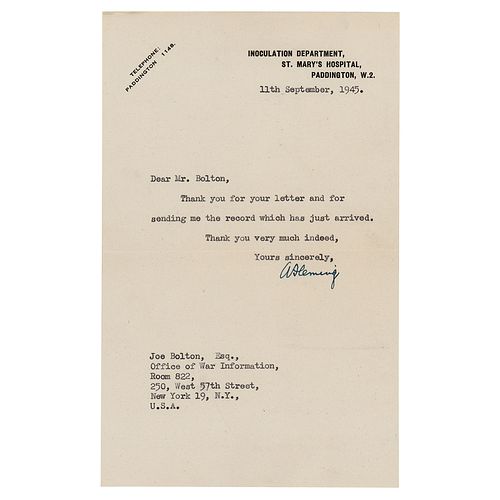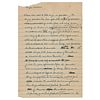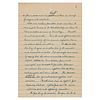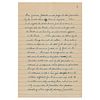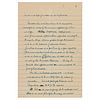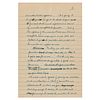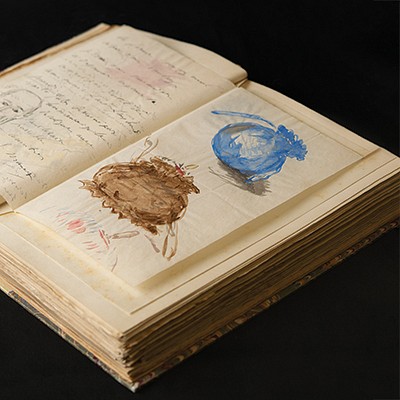Alexander Fleming Handwritten Manuscript on Penicillin
Two ways to bid:
- Leave a max absentee bid and the platform will bid on your behalf up to your maximum bid during the live auction.
- Bid live during the auction and your bids will be submitted real-time to the auctioneer.
Bid Increments
| Price | Bid Increment |
|---|---|
| $0 | $5 |
| $50 | $10 |
| $200 | $25 |
| $500 | $50 |
About Auction
Jun 14, 2023
RR Auction's June Fine Autographs and Artifacts sale boasts over 900 lots, highlighted by a special animation section of 200+ pieces of original production drawings, animation cels, and concept paintings from Disney classics like Snow White, Cinderella, and Alice in Wonderland. = RR Auction support@rrauction.com
- Lot Description
Fascinating AMS by Alexander Fleming, who penned this rough draft manuscript to use during an interview with Joe Bolton of the Office of War Information for a Voice of America broadcast near the end of World War II. The draft, 10 pages, 6 x 9, entitled “Pacific Broadcast,” is signed at the conclusion by Fleming, identifying it as a “Rough Draft,” who also makes numerous corrections and emendations in ink and pencil. Fleming forwarded this manuscript to Bolton with a TLS signed “A. Fleming,” one page, 5 x 8, Inoculation Department of St. Mary’s Hospital letterhead, September 11, 1945. The included letter, which is accompanied by its original mailing envelope, reads: “Thank you for your letter and for sending me the record which has just arrived. Thank you very much indeed.”
Fleming’s manuscript reads, in full: “I have been asked to talk to you on penicillin. The story of penicillin has been often told. A culture plate with which I was working in London in 1929 became contaminated by a mould. This mould was discovered to produce a substance which had a very powerful destructive action on many of the common bacteria which infect man. It belonged to the botanical class of Penicillium so I called the substance Penicillin. It was ten years afterwards before the penicillin was concentrated by Florey, Chain and their colleagues at Oxford University. Florey brought his methods over to America and induced the scientists and manufacturers here to go ahead and produce penicillin. In America the methods were improved. And production was increased in so phenomenal a manner that now there is enough for anyone who wants it.
Well now we have penicillin and we have to use it, and to use it to best advantage we have to have a certain amount of knowledge. Penicillin is not a cure-all. It is the most effective chemical known on many of our common infections but it is without action on others. It would take too long to give a complete list of the sensitive and insensitive microbes but we might summarise by saying that the common microbes which cause sepsis, septicaemia, bone disease, pneumonia meningitis are amenable to penicillin treatment as well as less common infections like anthrax actinomycosis and some others. The venereal infections too gonorrhea and syphilis are sensitive. But diseases such as typhoid fever, dysentery, cholera, typhus fever and the virus infections are not affected by penicillin.
The first thing to remember, therefore, is to be sure the infecting microbe is sensitive to penicillin for if it is not, you only waste time by using that drug.
The second thing to remember is that penicillin is only a chemical—although a very powerful one. It cannot jump or fly to the infected spot so it has to be administered or applied in such a way that it comes into contact with the infecting microbes.
It can be given in such a way that it reaches the blood stream and circulates around the body in the blood and so reaches the infecting microbes wherever they may be. This method is termed "Systemic" treatment and is relatively easy but is expensive in penicillin.
Sometimes it is possible to apply the penicillin directly to the infected area so that it reaches the microbes directly and without entering the blood stream. This is termed local treatment and is very economical in penicillin but it may be very difficult or impossible. Sometimes only systemic treatment is possible—sometimes local treatment is quite sufficient and sometimes it is better to combine the two methods.
When penicillin circulates in the blood it passes through all parts of the body including the kidneys and the kidneys rapidly remove it from the blood. This makes it necessary to keep up the supply or there will be so little left in the blood that it cannot harm the microbes. In the past this has generally been done by giving injections every 2 or 3 hours or by allowing the penicillin to drip continually into a vein or a muscle. This is all right when a patient is very ill in hospital. Then he does not mind what happens to him and this is perhaps the most effective way of giving penicillin. But penicillin has been given and will increasingly be given to patients who although infected are not very ill and who are not hospitalized. This method of 3 hourly injections does not suit this type of patient. As often as not he wants to be at his work. One injection or at the most two are possible.
This is a problem which has engaged the attention of many research men. They have tried to slow the rate of excretion from the kidney and certain drugs have been used which have this property. This method has not yet been seriously practiced as there is a fear that these drugs might damage the kidney which would be a serious matter.
Then they have tried to delay the rate of absorption of the injected penicillin into the blood. This has met with more success and Romansky at the Walter Reed Hospital in Washington has incorporated the penicillin in peanut oil and beeswax so that a whole days supply of penicillin can be contained in one or two injections. This is an advance but it is probable that something even better will be found in the near future.
Then, of course, patients would prefer to take penicillin by the mouth than have it injected. When it is injected the doctor knows just how soon it will get into the blood, how much will get into the blood and how long it will remain effective in the blood. When penicillin is taken by the moth things are not as certain. To a certain extent it depends on the state of the stomach—for instance the amount of acid or of food in the stomach. There can be enough acid in the stomach to destroy a large part of the penicillin swallowed and if the penicillin is enclosed in a capsule which passes undissolved through the stomach the penicillin may not be released until it has got down the intestine sufficiently far to be mixed up with the microbes normally existing there which are not only insensitive to penicillin but produce something which rapidly destroys penicillin.
So the administration of penicillin by the mouth is not without difficulties but in spite of these penicillin can be taken effectively by the mouth if about 4 times the amount is taken (That is four times the amount necessary if the penicillin were injected.). The penicillin for administration by the mouth has been made up in various ways to protect it from the acid in the stomach but again these are not final and a better method may be found any day.
Then for local treatment it will be made up in a variety of ways—creams or ointments or powders for direct application to the infected area—lozenges or chewing gum for mouth and throat infections—and sprays for wounds or for the respiratory tract. It has to be remembered that penicillin will only keep for a long time if there is not water present so that if any of these preparations contain water they would have to be used soon after they were made and not kept for weeks in a cupboard.
Penicillin has now been shown to be remarkably successful in many of the common infections from which we suffer. Streptococcal, staphylococcal and pneumococcal infections have responded wonderfully. It may be, though that its greatest benefit to mankind will be in the treatment of venereal disease. Gonorrhea is cured in a few hours by a few injections (It is now much less trouble than a cold in the head) and it looks as if early syphilis can be dealt with by something like two weeks treatment. It may be possible that effective control can now eradicate the first of these diseases.
Then there is bacterial endocarditis—a disease with almost a 100% mortality before the advent of penicillin. Now with prolonged treatment with large doses, 60 to 70% recover.
And its use is going to be extended now that it is more plentifully to many somewhat trivial infections. It is going to be of great benefit to the dental surgeon for nearly all the mouth infections are caused by microbes susceptible to penicillin. Most of the infections of the nose and throat are likewise susceptible but it may require much skill and patience to get the penicillin into contact with the microbes in infected sinuses.
One thing we who use penicillin should always remember is that it is quite nonpoisonous. It is the only one of the antibacterial drugs which is quite nonpoisonous. We need never be afraid of giving an overdose and now that there is plenty of penicillin we should see to it that we give doses large enough to destroy the microbes not doses just enough to educate the microbes to resist the drug. Inadequate doses only lead to trouble. Sufficient penicillin administered to patients infected with sensitive bacteria gives spectacular results.” In overall fine condition, with minor paper loss to the top edge of the first page.
On October 26, 1945, a month after forwarding this letter and manuscript, Fleming then busy in his laboratory at St. Mary's Hospital Medical School in London, was informed that he had won the Nobel Prize in Physiology or Medicine, and would jointly receive the award with Ernst Chain and Howard Florey for their discovery and development of penicillin. The Nobel Prize was a significant recognition of Fleming's work and its impact on medicine, and it cemented his place in history as one of the most important scientists of the 20th century.
Bolton later became famous as ‘Chief Bolton,’ the host of several children's television shows in New York City. The only similar item ever to have sold at public auction was at Sotheby's auction in 1988 and was a less detailed manuscript, (only seven pages) for a BBC show.
In the summer of 1945, physician and bacteriologist Alexander Fleming, who discovered penicillin in 1928, visited the United States to tour military and civilian hospitals to confer on the uses of penicillin and also to discuss the production of penicillin with pharmaceutical companies. He also made various presentations on penicillin and its uses on radio programs. He appeared on The March of Time, a radio news documentary series produced by Time Inc. from 1931 to 1945, in an episode that aired in late May and early June on various stations. He also spoke from Yale University on the Human Adventure series that broadcast on July 11, 1945, and in the series The Doctor Fights, starring actor Ronald Colman that broadcast in early July.
The Office of War Information operated from June 1942 until September 1945 to share news from the battlefront with civilian communities through radio broadcasts, newspapers, posters, photographs, and films. It also established offices overseas, from which it operated a large-scale information and propaganda campaign. It also assumed responsibility for the Voice of America, which had been established to broadcast pro-American content around the globe.
A radio announcer and army veteran of World War II, Joe Bolton worked for a time as executive director of the Office of War Information in New York City. In the summer of 1945, Bolton conducted two in-depth interviews with Alexander Fleming for the Voice of America. Bolton recalled in 1968 that he had interviewed famous people from all walks of life, and especially remembers a friendship he struck up with Sir Alexander Fleming, the discover[er] of penicillin. After an on-the-air interview, he and Fleming corresponded for several years. 'I even have a longhand paper Sir Alexander wrote on penicillin for the Voice of America program. I asked him to sign it and now I keep it in a safety-deposit box.' (The Herald-News [Passaic-Clifton, NJ], August 7, 1968) - Shipping Info
-
Bidder is liable for shipping and handling and providing accurate information as to shipping or delivery locations and arranging for such. RR Auction is unable to combine purchases from other auctions or affiliates into one package for shipping purposes. Lots won will be shipped in a commercially reasonable time after payment in good funds for the merchandise and the shipping fees are received or credit extended, except when third-party shipment occurs. Bidder agrees that service and handling charges related to shipping items which are not pre-paid may be charged to a credit card on file with RR Auction. Successful international Bidders shall provide written shipping instructions, including specified Customs declarations, to RR Auction for any lots to be delivered outside of the United States. NOTE: Declaration value shall be the item’(s) hammer price and RR Auction shall use the correct harmonized code for the lot. Domestic Bidders on lots designated for third-party shipment must designate the common carrier, accept risk of loss, and prepay shipping costs.
-
- Buyer's Premium



 EUR
EUR CAD
CAD AUD
AUD GBP
GBP MXN
MXN HKD
HKD CNY
CNY MYR
MYR SEK
SEK SGD
SGD CHF
CHF THB
THB